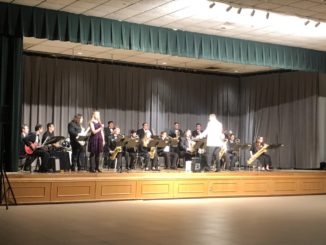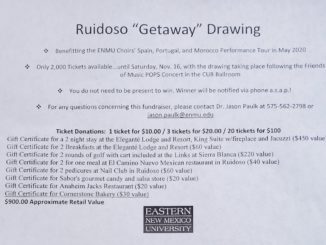By: Allen Valdez
The uncomfortably familiar sound of an alarm resonates on a dim morning before a tired student athlete awakes with an intent of exceeding limitations before a grueling workout. As the athlete gears up for the long morning ahead, a rhythmic pulse found on a Spotify playlist sends a flow of energy throughout the athlete’s body.
On the same day, a confident music major is waving a conducting baton to a performance from Maestro Michael Tilson Thomas leading the San Francisco Symphony on YouTube. The student hurries along through campus before playing an anticipated concert that will be recorded and available on the ENMU Music Department channel on the very same platform shared by Michael Tilson and other great American conductors.
Everywhere on the ENMU campus, one can find a plethora of ear buds connected to devices with channels for different apps/websites of musical entertainment and research. As technology has advanced the past few decades so has how music and its entities availability to the public. So, how does a monetary system function for music to be so available?
Music publishers are intercessors that ensure a songwriter/composer receives payment from any commercial use of a published work with the aid of granted licenses and royalty collections from Performing Rights Organizations (PRO) such as the American Society of Composers Authors, and Publishers (ASCAP) or Broadcast Music, Inc. (BMI), as well as in many cases promoting the licensed material. Attaining the correct licenses is the first step before any royalty distribution can be received. Major music publishing companies such as Sony, Warner Brothers, EMI and others have a large expansion of music catalogs as well as branching to other forms of entertainment, e.g. Sony owning the PlayStation franchise. These companies have huge financial incentives and distribute royalties to a wide array of famous entertainers from Kendrick Lamar to John Williams. Indie music publishers are individually owned and operate in mostly advertising and selling published works through a smaller scope, but also give the writer/composer freedom outside of demographics, such as advertising works that may not be contemporary or popularly accepted to the public eye. Intermediate “major” companies have larger financial capabilities than Indie publishers yet fall short commercially to the powers of larger music publishers like Warner Bros.
Publishing royalties have different platforms for distribution such as mechanical and performance royalties. There are other forms of royalty distribution, but I would like to focus on the distribution for the two most common musicians—the performer and the recording artist. The performer can be anyone from a jazz clinician playing written scores and an acoustic solo artist that plays at the local coffee shop on the weekends. In terms of royalty distribution for the performer, a song is acknowledged for the songwriter rather than the performer. In these cases, the songwriter is accredited for public performances that include web services like Pandora in a restaurant or similar public setting. A mechanical royalty can be defined by a streaming service or music collected off of a physical platform such as a vinyl record which generally means nine cents to every dollar earned for that artist.
Administration agreements provide 100 percent ownership of the copyright to the author of the licensed material with typically the help of a third party responsible for licensing and royalty distributions both domestic and foreign in relation. An administrator does not own any of the rights but administers those works. The largest incentive of administration deals is the percentage of royalties gained for the writer/composer.
In a typical setting, a third party would administer 10 to 20 percent of the royalty depending on origin of place of said royalty whereas in a common co-publishing deal a writer/composer would typically retain 50 to 75 percent of the income generated. The weakness of an administration agreement can be that the third party may retain no creative outlets to promote and distribute material. Acquiring a third party is not a requirement, but it does ease the author’s focus less on being knowledgeable about copyright laws and more so on the writing/composing adding volume to the collection of licensed catalogs.
The most common publishing deals are co-publishing agreements with a 50 percent split ownership between the music publisher and writer/composer. Music publishers ensure creative outlets for the promotion and distribution of copyrighted materials and collect royalties domestically and internationally with the possibility of aid from another party, such as the Harry Fox Agency that specializes in licensing in royalty affairs with collecting and distributing. Music publishers hold advantages by commonly associating large entities like PRO such as ASCAP or BMI.
A PRO such as ASCAP provides a library of music catalogs to various platforms of entertainment such as TV and film. An experienced publishing group can be extremely beneficial with a team of individuals marketing, networking, and creating new business opportunities associated with licensed material for the best platforms of promotion. A music publisher may also set up a budget for the songwriter/composer for any related needs such as recording essentials for copyrighted materials, which can be a large financial shift for material with great potential, but poor financial means for distribution. Co-publishing agreements can be both complex and tedious for an author of works of music, however with the right co-publisher would retain only 50 percent of the rights but deal with most of the copyright laws, licensing and promotion of the catalogs of music. An author of licensed works does not fully own a complete copyright outside of a co-publishing or administration deal, it would belong to a company started by the author after associating with a PRO to earn any royalty.
Self-publishing is difficult in many aspects, but it allows the composer/writer freedom of the copyright. This entails a larger percentage in revenue from the royalties as well as what the copyrighted work is used for. A corporate publisher is convenient with larger networking abilities, but at the cost of the copyright and the power to commercially use the copyrighted material with little-to-no-say from the writer/composer. A self-publisher usually starts out by associating with a PRO like ASCAP or BMI as both a publisher and as the writer/composer to protect written materials. Promoting material and other artists can seem intimidating, but with the popularity of social media and music communities such as SoundCloud that share music, it can be more tangible than ever.
Self-publishing doesn’t mean you have to be completely alone in your endeavors to successfully network and distribute works, hiring publicists and a team of experienced individuals to handle such things as websites and any music pages. There are also organizations that hold memberships for songwriters and composers to share information and events for furthering careers such as The Society of Composers. Supporting other composers and colleagues help not just to network, but collaboration and career advice in various forms such as events to attend or simple critiques. Websites, such as Sheet Music Plus, buy music without taking rights; some do charge a standard fee. Other websites specialize in specific genres such as Barnhouse that specializes in concert music.
The music is always evolving with technology and so does the business itself. Not everyone is a musician or composer, but music is everywhere. The importance of knowing the monetary system for music may sound subjective for the composer, but as we live in a capitalistic society, it can become a place for investment and a channel for cash flow. The next time you find yourself at restaurant or at home and you hear Pandora in the background, whoever is playing on the station is being paid for you to listen per minute. Can you imagine if you were receiving a check in the mail one day for that minute and many more?



